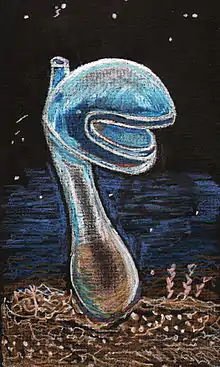Predatory tunicate
The predatory tunicate (Megalodicopia hians), also known as the ghostfish,[2] is a species of tunicate which lives anchored along deep-sea canyon walls and the seafloor. It is unique among other tunicates in that rather than being a filter-feeder, it has adapted to life as an ambush predator. Its mouthlike siphon is quick to close whenever a small animal such as a crustacean or a fish drifts inside. Once the predatory tunicate catches a meal, it keeps its trap shut until the animal inside is digested. They are known to live in the Monterey Canyon at depths of 200–1,000 metres (660–3,280 ft). They mostly feed on zooplankton and tiny animals, and their bodies are roughly 5 inches (13 cm) across.[3]
| Predatory tunicate | |
|---|---|
 | |
| A drawing of the predatory tunicate Megalodicopia hians | |
| Scientific classification | |
| Kingdom: | Animalia |
| Phylum: | Chordata |
| Subphylum: | Tunicata |
| Class: | Ascidiacea |
| Order: | Enterogona |
| Family: | Octacnemidae |
| Genus: | Megalodicopia |
| Species: | M. hians |
| Binomial name | |
| Megalodicopia hians Oka, 1918[1] | |
Predatory tunicates are hermaphrodites, producing both eggs and sperm which drift into the water. If there are no other tunicates nearby, they can self-fertilize the eggs.[4]
References
- Karen Sanamyan (2010). Noa Shenkar; Arjan Gittenberger; Gretchen Lambert; Marc Rius; Rosana Moreira Da Rocha; Billie J. Swalla (eds.). "Megalodicopia Oka, 1918". World Ascidiacea Database. World Register of Marine Species. Retrieved June 28, 2011.
- "Marine Organism of the Week". 28 September 2014.
- "Predatory tunicate Megalodicopia hians". www.montereybayaquarium.org. Retrieved 2021-06-02.
- "Predatory tunicate Megalodicopia hians". www.montereybayaquarium.org. Retrieved 2021-06-02.